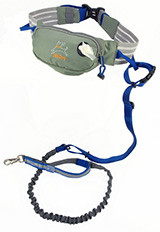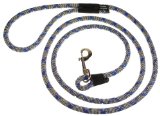OllyDog Mt. Tam Hands-Free Running Lead and Belt Pack - 2 Colors


Run Time! Practical Solutions To Running!
Running leads will conveniently adjust to fit around your waist for hands-free operation while running with your best 4-legged friend. This enables a more confortable and free running experience for you. Dogs should be well trained before attaching a lead to you hands- free, as sudden lurching by the dog can promote an unexpected jerk or fall to your body. Having your hands on a lead at all times definitely enables you to have more constant control of your dog, but when properly used, a hands-free lead is certainly worth the freedom it brings.
OllyDog brings us the Mt. Tam, a really fun, functional version that can be used two ways: 1. with the included waist-belt pack that holds all your essentials, or 2. as a waist leash without the belt pack system. We love the well thought-out belt pack and both the traffic lead and elastic shock-safety feature built into the lead. These exceptional details make the Mt. Tam a smart and thorough choice.
Let's first delve into the Mt. Tam belt pack system. Our favorite feature is a little hole on the front of the pack that allows you to pull through a poop bag, but is equally usefull for pulling through your earbuds with your phone or mp3 still safely zipped inside. The bag has room for keys, phone, doo bags, and even treats. Olly Dog also gives you a choice of which side to attach the leash.
As for the leash, do beware, as this leash is longer than some. This is because the lead is made to also adjust around your waist without the pack and because of the built-in bungee safety system. We think the extra length is very workable with practice and because we would not want to sacrifice either feature. The bungee safety aspect is an especially wonderful addition whether running or walking with your dog hands free. It obsorbs any sudden movement forward or stopping behind you, leaving your experience jerk-free. The built-in traffic lead has a reflective strip for added safety and allows you to tether in and control your dog quickly.
Please take time to read before purchasing a lead -
Delinda's Basic Facts about Dogs and Leads:
The Leading Facts: Leads are not only basic, standard equipment, in our culture today, they are also law. Leads ensure a fundation of safety and control - not just safety for ourselves and the people that surround us in busy urban areas, but also for the safety of our companion animals who often do not understand the compexities and dangers that our human society and lifestyle can present for them.
I am offering some of my favorite leads here for your own reveiw and discernment. I beleive all these leads to be of quality materials that will serve you long and well under normal conditions of use. Some of these leads serve for multiple functions and others are specialized styles.
Supervision is Neccessary: Leashes are not chew-proof for dogs, no matter their material. All leashing must be carefully monitored, especially in the beginning of your relationship with your dog and always with puppies. With some dogs, training to not chew the leash is imperative. Simple training prevents hair pulling, knashing of teeth and depleted budgets. Every dog can be trained not to chew the lead. This training must be followed through in varied situations and environments, both with you on the other end and without you on the other end of the lead, e.g. brief posting periods. There is more on lead training via the audios and videos presented on this site in the Training section.
Safety On Lead: As with most things in just living life, there are definite safety considerations for you and your dog when using a lead. Here are a few. 1. Make sure your lead and collar system is always in top operational shape. Faulty and worn stitching and lead material, loops and fasteners should be quickly replaced. Collars should not be able to be slipped. 2. Leads can easily get wrapped around you and other items without the dog realizing. Dogs can then pull you down accidentally if the lead is caught up on your foot or tangled in your hands. 3. Dogs can do unexpected things, like suddenly give chase to another animal, such as a squirrel, in a park or front yard. This is especially a consideration when using a hands-free lead. Proper training and your responsible awareness goes a long way to prevent sudden, unexpected behaviors and the aftermath that can follow. 4. Leads should not be used to post dogs in unsafe areas or spaces that might render your dog too exposed to things to which they may not have been previosly exposed or introduced. Only post a dog in safe areas and environments that you know to be comfortable to them. It takes practice and solid socialization to be able to safely post your dog outside and walk in to grab a coffee, for example.
Equipment Availablity: Every household should have more than one lead. It is handy to have one by the door and one in each vehicle. There are other places you might want to stash extra leads, like in certain bags or camping equipment. Being prepared is so much better than finding you don't have the right equipment to either properly care for your dog or to include your dog in your outing. It is also nice to be able to offer others a lead when they have forgotten theirs. Personally, I have multiples in each location. Traffic leads are great to have in a pinch in lieu of a standard lead. They are small, can hang off a belt or fanny pack without being burdensome. And you never know, you might be able to use that extra lead to facilitate a rescue too! Leads are always imperative, standard equipment for every dog loving person.
I hope you find this information affirming or inspiring of thought on the best relationship you can foster with your dog. You will also find more specific information on how to properly utilize and train with the lead through articles in our Dogology magazine, Dogology training audios and videos, or through books and digital media recommended and offered here in our products pages.
Freedom Off-Lead: I used to naively think in my youth that dogs should be "free". At the time, I did not ever want to collar or leash my dog. My dog sported a bandana. There were the beginnings of leash laws at the time, but mostly, they were either non-existant or loosly upheld. Luckily Jazz, my dog at the time, was extremely bonded to me and super, super obedient. She traveled all over the US with me via car and plane, as work at the time took me traveling a lot. She was an amazing dog and had a much larger than most vocabulary and understanding of what I wanted and expected of her. Because of her amazing obedience and vocabulary, she was welcomed everywhere. Even places that normally would not allow dogs welcomed Jazz. She became a bit of a celebrity in some places, which was endearing to have her so welcomed and appreciated.
All that said, I would never again handle a dog in the same way today. Liability issues and leash laws now being firmly in place in most of our country is reason enough to adopt strict lead practices. In addition, understanding canine behavior gives us other very compelling reasons to do the same. Thankfully, I now understand a whole lot more on the subject and when, where, and why the importance of leading your dog comes into play.
What are some of the reasons leads are such an important and handy tool? First, we are our dog's protectors, not the other way around. Even though we sometimes obtain a dog for protection, we must first keep them safe so they can do their job. Leads protect them from possible harm and they do not take away their freedom. In fact, leads today give dogs the freedom to move around more predominatly and acceptably in our human environments.
Secondly, I believe dogs must earn freedoms through their ability to have reliable obedience, especially recall, in multiple distractive situations. This is earned by us through consistent training and fair, consistent leadership. It takes time to build this relationship of complete trust with your dog, and thus, reliable obedience. Freedom should never be assumed and never given when there is unreliable obedience control, as this presents too many chances for harm to occur. I know I myself am unwilling to take those chances with my best buddy, as they do not make sense. So, until you have reached that point with your dog and even afterwards in public situations, leads are an imperative tool.
Thirdly, it is through the lead and appropriate handling of the lead that you develop a deep bond and trust. The lead can also build securtiy for every dog, but most especially for the submissive dog. In conclusion to the above, the lead is a postive tool for safety, pack connection, and leadership when used properly. Lastly, leashing is law.
Thank You and Happy Leading! - Delinda



